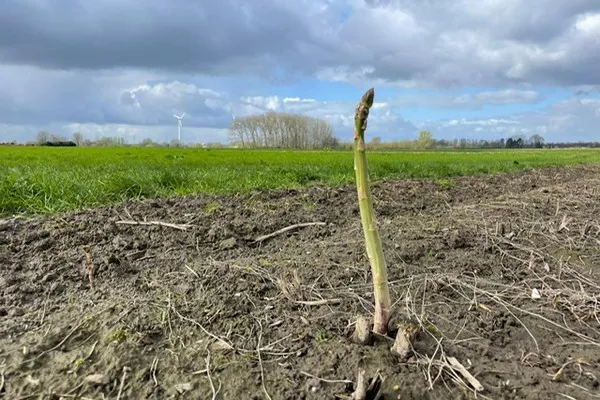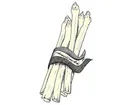“Green asparagus enjoys less publicity but is very popular among young people”

“For green asparagus, you don’t need to dig and fill holes,” she continues. “It’s simply a matter of cutting, after which it’s quickly ready for sale. On the other hand, it’s also a fun product for consumers, as they don’t need to peel it, and it’s softer in texture. This means you can prepare it in different ways, not just boiling or steaming. For example, it’s ideal for grilling or stir-frying in a wok, allowing you to put a healthy dish on the table in no time. This is why it particularly appeals to young people. A quick bite in the asparagus family. For us, it’s a crop that fits perfectly into our operations.”
Green asparagus also has roughly the same season as white asparagus, Katrien explains. “They just start a bit later. You can advance the white asparagus with heating under plastic or cloches. However, the green variety grows mainly on its own strength, but they also finish at the traditional end of June 24th (ed. St. John’s Day). This means a shorter period, and you also get slightly fewer kilos because the green is a finer variety where you don’t want thick stems. It means less yield, but that compensates with price. The green ones typically go for a higher price than the white asparagus. It doesn’t matter, because the green ones are often used as an addition to a dish, whereas white asparagus often stars and thus more is consumed per dinner.”

“Moreover, it’s a crop that is less dependent on weather conditions. We grow on sand/loam soil, which means the rain is essentially drained away by the sand. On the other hand, loam ensures that just enough water is retained to supply the asparagus. Therefore, you almost never have problems with waterlogging, but you still keep enough moisture to maintain the soft texture in the asparagus. A significant difference compared to its white sibling.”
Good prices, but limited volumes of white asparagus
Because, as Katrien states, that product suffers a lot more from the drizzly spring weather. “It has really been sluggish this season for white asparagus. It was naturally a very early season, allowing us to start before Easter. However, the temperatures were low throughout the spring. I think we’ve only had 3 days of good weather, which slightly increased production. Then we immediately suffered for a week because prices plummeted. However, this recovered almost immediately. The limited volumes, on the other hand, have led to acceptable prices.”
“Looking at it now, we are at 6 to 8 euros for good quality, where last year we were dealing with prices around 3 to 4 euros. That’s almost double the price. On the other hand, there’s also quite a bit of lower quality. The excess water also led to a certain percentage of growers not starting because they were on too wet a plot, preventing them from making the ridges. Moreover, there were growers with older plots who stopped earlier because the percentage of class II was too high. The result is that the supply seems to be getting more limited in the last weeks of the season, and prices will certainly not decrease. Should we get nice weather, causing consumption to spike, I even think we’re heading into an even more expensive period.”
 “Let’s hope so,” Katrien continues. “There are still few people who have been able to enjoy delicious asparagus on the terrace. If it finally happens, the barbecues will be fired up and the consumption of all vegetables and soft fruits will probably finally get going. You see it in tomatoes and lettuce as well. Consumption is low due to the bad weather, and prices remain low as a result. For prices, consumption, and product quality, it’s slowly but surely time for the sun to show itself.”
“Let’s hope so,” Katrien continues. “There are still few people who have been able to enjoy delicious asparagus on the terrace. If it finally happens, the barbecues will be fired up and the consumption of all vegetables and soft fruits will probably finally get going. You see it in tomatoes and lettuce as well. Consumption is low due to the bad weather, and prices remain low as a result. For prices, consumption, and product quality, it’s slowly but surely time for the sun to show itself.”
Cherries and apricots
This is a hope many will share with Katrien. She also sees in other products that it’s time for warmth and sunshine. “The cherries could use some too. We’ve started picking since Mother’s Day. A bit earlier than last year, so we’re working with good prices. The volumes are still quite limited and the cherries from Spain and France are also quite firm in price. So, it’s really for the enthusiast willing to pay a bit more. But we see that everything is still too damp.”
“The best scenario is for the crop to be dry every morning with sunshine. But the climate remains too moist, causing a minor damage to quickly escalate. In the greenhouse, as we grow them, it’s still relatively okay. Yet, we’re already seeing it and in the early varieties that are outside, it’s all wait and see. Even the rain that falls next to the trees is absorbed by the roots, causing the cherries to potentially burst. We’ll have to see how it turns out. Nature is hard to deceive or even seduce. On the other hand, it’s very nice that we can start again with a beautiful product. Let’s certainly not forget the beauty.”

Katrien wants to end on a positive note. “All Belgian products are coming back to market and more and more are being added. We also started with the first pick of our apricot cultivation last week. They are apricots with a pink skin instead of the traditional orange, and it has been very successful. Last year we had the first harvest, but this year the trees are actually perfectly full for the first time. It’s just beautiful to see and I think a time like this just shows that it’s not a given that delicious products are available on the shelves. It all seems easy to come by, but consumers should realize that it’s genuinely a miracle when beautiful products are available,” concludes Katrien.
For more information:
Amelinckx Asparagus & Fruit
Koningin Astridlaan 171
2880 Hingene, Belgium
+32(0)475 26 99 15
info@topasperges.com
www.topasperges.com

“For green asparagus, you don’t need to dig and fill holes,” she continues. “It’s simply a matter of cutting, after which it’s quickly ready for sale. On the other hand, it’s also a fun product for consumers, as they don’t need to peel it, and it’s softer in texture. This means you can prepare it in different ways, not just boiling or steaming. For example, it’s ideal for grilling or stir-frying in a wok, allowing you to put a healthy dish on the table in no time. This is why it particularly appeals to young people. A quick bite in the asparagus family. For us, it’s a crop that fits perfectly into our operations.”
Green asparagus also has roughly the same season as white asparagus, Katrien explains. “They just start a bit later. You can advance the white asparagus with heating under plastic or cloches. However, the green variety grows mainly on its own strength, but they also finish at the traditional end of June 24th (ed. St. John’s Day). This means a shorter period, and you also get slightly fewer kilos because the green is a finer variety where you don’t want thick stems. It means less yield, but that compensates with price. The green ones typically go for a higher price than the white asparagus. It doesn’t matter, because the green ones are often used as an addition to a dish, whereas white asparagus often stars and thus more is consumed per dinner.”

“Moreover, it’s a crop that is less dependent on weather conditions. We grow on sand/loam soil, which means the rain is essentially drained away by the sand. On the other hand, loam ensures that just enough water is retained to supply the asparagus. Therefore, you almost never have problems with waterlogging, but you still keep enough moisture to maintain the soft texture in the asparagus. A significant difference compared to its white sibling.”
Good prices, but limited volumes of white asparagus
Because, as Katrien states, that product suffers a lot more from the drizzly spring weather. “It has really been sluggish this season for white asparagus. It was naturally a very early season, allowing us to start before Easter. However, the temperatures were low throughout the spring. I think we’ve only had 3 days of good weather, which slightly increased production. Then we immediately suffered for a week because prices plummeted. However, this recovered almost immediately. The limited volumes, on the other hand, have led to acceptable prices.”
“Looking at it now, we are at 6 to 8 euros for good quality, where last year we were dealing with prices around 3 to 4 euros. That’s almost double the price. On the other hand, there’s also quite a bit of lower quality. The excess water also led to a certain percentage of growers not starting because they were on too wet a plot, preventing them from making the ridges. Moreover, there were growers with older plots who stopped earlier because the percentage of class II was too high. The result is that the supply seems to be getting more limited in the last weeks of the season, and prices will certainly not decrease. Should we get nice weather, causing consumption to spike, I even think we’re heading into an even more expensive period.”
 “Let’s hope so,” Katrien continues. “There are still few people who have been able to enjoy delicious asparagus on the terrace. If it finally happens, the barbecues will be fired up and the consumption of all vegetables and soft fruits will probably finally get going. You see it in tomatoes and lettuce as well. Consumption is low due to the bad weather, and prices remain low as a result. For prices, consumption, and product quality, it’s slowly but surely time for the sun to show itself.”
“Let’s hope so,” Katrien continues. “There are still few people who have been able to enjoy delicious asparagus on the terrace. If it finally happens, the barbecues will be fired up and the consumption of all vegetables and soft fruits will probably finally get going. You see it in tomatoes and lettuce as well. Consumption is low due to the bad weather, and prices remain low as a result. For prices, consumption, and product quality, it’s slowly but surely time for the sun to show itself.”
Cherries and apricots
This is a hope many will share with Katrien. She also sees in other products that it’s time for warmth and sunshine. “The cherries could use some too. We’ve started picking since Mother’s Day. A bit earlier than last year, so we’re working with good prices. The volumes are still quite limited and the cherries from Spain and France are also quite firm in price. So, it’s really for the enthusiast willing to pay a bit more. But we see that everything is still too damp.”
“The best scenario is for the crop to be dry every morning with sunshine. But the climate remains too moist, causing a minor damage to quickly escalate. In the greenhouse, as we grow them, it’s still relatively okay. Yet, we’re already seeing it and in the early varieties that are outside, it’s all wait and see. Even the rain that falls next to the trees is absorbed by the roots, causing the cherries to potentially burst. We’ll have to see how it turns out. Nature is hard to deceive or even seduce. On the other hand, it’s very nice that we can start again with a beautiful product. Let’s certainly not forget the beauty.”

Katrien wants to end on a positive note. “All Belgian products are coming back to market and more and more are being added. We also started with the first pick of our apricot cultivation last week. They are apricots with a pink skin instead of the traditional orange, and it has been very successful. Last year we had the first harvest, but this year the trees are actually perfectly full for the first time. It’s just beautiful to see and I think a time like this just shows that it’s not a given that delicious products are available on the shelves. It all seems easy to come by, but consumers should realize that it’s genuinely a miracle when beautiful products are available,” concludes Katrien.
For more information:
Amelinckx Asparagus & Fruit
Koningin Astridlaan 171
2880 Hingene, Belgium
+32(0)475 26 99 15
info@topasperges.com
www.topasperges.com
